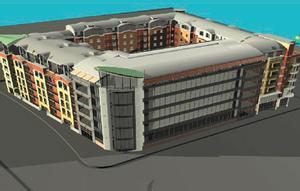When designing a naturally ventilated underground car park the most common challenge is to incorporate a sufficient number of openings to make the design comply with Building Regulations. Approved Document F specifies that the ventilation requirement will be satisfied if the openings at each car parking level have an aggregate area equal to at least 5% of the floor area at that level, of which at least half should be in two opposing walls. This may often be difficult to achieve in practice, particularly if the car park is below ground.
Sufficient ventilation can sometimes be provided even if the opening area and distribution requirement is not fulfilled, such as a residential car park which would not be used as frequently as a shopping centre car park.
Approved Document F also allows an alternative approach. The requirement will be satisfied if the ventilation is designed to limit the concentration of carbon monoxide to not more than 50 ppm averaged over 8 h, and peak concentrations (such as by ramps and exits) do not go above 100 ppm for periods not exceeding 15 minutes.
Sometimes this is not possible, and it will be necessary to adopt an alternative approach in which the ventilation strategy is designed to limit the concentration of carbon monoxide to an acceptable level over a set number of hours.
With residential developments, this latter approach is often appropriate as car park usage is intermittent and there is less likelihood of pollutant build-up.
Natural ventilation
The performance of natural ventilation depends on many factors including site layout and orientation, the size and siting of air vents, the height and proximity of neighbouring buildings, and local wind conditions.
When these are favourable, natural ventilation will provide both a mean level of air change and be able to cope with peak conditions. Where conditions are not ideal there will be periods when it is unable to cope with heavy loads and ventilation rates will fall below a desirable level.
In these circumstances it is necessary to understand just how low those rates could fall and what impact this would have on air quality and the health and safety of users. The effect of extended periods of low wind speed (and thus low ventilation rate) on CO levels is of particular interest.
Pollutant concentration
As well as the overall ventilation rate, it is important to consider the distribution of pollutant concentrations within the car park. The assumption that the air is well-mixed and the concentrations are uniform is often used when predicting concentrations.
However, it is important to examine the factors which may contribute to non-uniform mixing and to determine the sensitivity of the predicted concentrations to assumptions about the degree of mixing. The two interacting factors that contribute to the degree of mixing are the air flow pattern within the space and the location of the pollutant sources.
The principle factor which influences the pattern of air flow is the distribution of air inlets. The strength of the mixing effect will depend upon the speed of the incoming air and the size of the inlet opening.
Air extract points have a much lower effect on air movement but their location relative to inlets may be important. Other factors to take into account include the geometry of the space, convective flows and intermittent turbulent flows.
With car parks, the pollutant source is moving for much of the time and the distribution will depend on the routes that vehicles have to take. For example, if there is a single entry and exit point, there will be a higher generation of pollutant on travel paths in the immediate vicinity.
At the same time, the complex interaction of air flow and pollutant sources makes it very difficult to predict pollutant distribution. An elongated space with openings at one end is likely to have a non-uniform distribution, while a single pollutant source which is close to the openings will have a much lower concentration than if it were located deeper into the space.
Determining the true situation
Predictions of ventilation rate are based on estimates of the effective area of openings and of surface pressure coefficients. While the latter can be obtained from existing published data, the coefficient values will be sensitive to local topographical features and the height and form of neighbouring buildings. It is therefore necessary to judge the suitability of existing data and in the light of this, to ascertain the need for wind tunnel tests.
A case study serves to illustrate these points. Century Buildings in St Helier, Jersey is a high quality mixed-use scheme. The project, designed by Naish Waddington Architects for the developer, Dandara, comprises over 5000 m2 of offices, plus a creche, a shop, a bar and restaurant, a café, and over 160 apartments with a central landscaped courtyard and basement parking for over 120 cars.
The development will have a general height of 22 m and be set on a broadly rectangular site approximately 60 m x 70 m, close to the centre of St Helier. It is set around a central courtyard, with a single level basement car park for over 120 cars.
Vehicle entry and exit will be via a single opening consisting of a ramped tunnel under the north east side and terminating in a side road. The basement will contain a number of plant rooms and storage spaces and the overall area allocated for car parking is approximately 2500 m2.
The designer's preferred option is natural ventilation, to be achieved via openings on each of the four facades and a central opening in the roof of the car park, venting into the courtyard (figures 1).
In this instance, BRE used existing published data and advised there was no need to undertake a wind tunnel test. Hourly ventilation rates were predicted using hourly mean wind speed data over a 10 y period.
By determining the expected use pattern of the car park, it was possible to predict the variation in hourly mean CO concentrations over the 10 y, assuming that the pollutants were uniformly distributed. From this, the percentage of time that 1 h and 8 h mean CO concentrations exceeded 50 ppm and 100 ppm respectively could be determined. The effect of non-uniform mixing on these results was also investigated.
The findings
Predictions of natural ventilation rates over a 10 y period indicated that the estimated average level of ventilation was lower than would be expected for an above ground car park that complied with Approved Document F.
The predicted car use and the degree of non-uniform mixing of air meant that CO concentrations were likely to exceed the acceptable limit, particularly in the north-east area of the car park where ventilation was relatively poor and pollutant emissions would be high because of proximity to the entry/exit point.
The client was advised that mechanical ventilation using the rates suggested by Approved Document F should restrict CO levels to well within the prescribed limits even for the highest car usage patterns.
As a result of the developer commissioning an independent report, the architects were able to progress their application for Jersey building by-laws more effectively. The Building Control department accepted that the case for natural ventilation versus mechanically assisted ventilation of the semi-basement car park was not black-and-white, and were therefore prepared to accept BRE's recommendations.
Although the BRE was unable to recommend a cheaper, naturally ventilated strategy, the exercise avoided considerable potentially abortive work by the design team and loss of time by the client. The design team was able to concentrate on the complex structural and m&e co-ordination from the earliest stages, with a very clear idea of the proposed final concept.
In this instance, the BRE recommended that the design team verify the predicted pollutant levels through thorough commissioning.
Downloads
Cross-section through the Century Buildings development
Other, Size 0 kb
Source
Building Sustainable Design
Postscript
Ursula Garner is with the BRE's Environment Division.




















